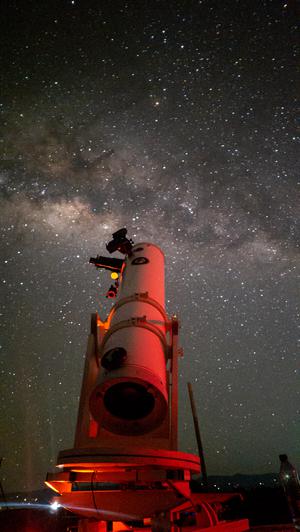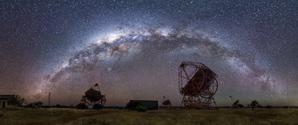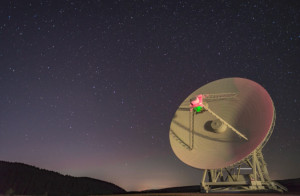Glossary term: Observation
Description: Les observations astronomiques consistent à collecter et/ou à mesurer le rayonnement électromagnétique, les particules ou les ondes gravitationnelles qui nous parviennent d'un objet astronomique. Dans le passé, les hommes observaient avec leurs yeux et, depuis le début des années 1600, avec des lunettes astronomiques et télescopes. Aujourd'hui, il est possible d'utiliser une variété de caméras, de spectromètres et d'autres instruments. Les informations collectées, telles que l'image brute obtenue à partir d'un appareil photo, sont appelées données (d'observation).
Ces données contiennent des informations sur l'objet et le milieu environnant (par exemple le milieu interstellaire ou intergalactique), mais dépendent toujours des spécificités de l'instrument, par exemple si une partie de la caméra est plus sensible qu'une autre. Les données dépendent également des contaminants ; par exemple, lorsque nous recueillons la lumière d'un objet astronomique, nous recueillons également la lumière d'avant-plan diffusée dans l'atmosphère terrestre. La réduction des données consiste à éliminer le plus complètement possible les parties spécifiques à l'instrument et les contaminants. Les produits finaux typiques des observations sont les images, les spectres et les séries temporelles (observations répétées du même objet ou des mêmes objets, par exemple les données des pulsars ou des étoiles variables). Ces données peuvent être utilisées pour mesurer diverses quantités telles que l'angle entre deux objets, l'heure à laquelle un événement a été observé ou la magnitude apparente d'un objet.
Les observations diffèrent des expériences menées dans de nombreux laboratoires scientifiques, car l'observateur ne peut pas interagir avec les objets astronomiques eux-mêmes, comme le ferait un chimiste en mélangeant deux produits chimiques. Dans certains contextes, les observations peuvent parfois être complétées par des expériences sur les objets eux-mêmes, comme l'étude des météorites ou l'envoi de sondes spatiales vers des objets du système solaire.
Related Terms:
- Magnitude apparente
- Rayonnement électromagnétique
- Observatoire
- Particule
- Spectre
- Ondes gravitationnelles
- Étoile variable
See this term in other languages
Term and definition status: The original definition of this term in English have been approved by a research astronomer and a teacher The translation of this term and its definition is still awaiting approval
The OAE Multilingual Glossary is a project of the IAU Office of Astronomy for Education (OAE) in collaboration with the IAU Office of Astronomy Outreach (OAO). The terms and definitions were chosen, written and reviewed by a collective effort from the OAE, the OAE Centers and Nodes, the OAE National Astronomy Education Coordinators (NAECs) and other volunteers. You can find a full list of credits here. All glossary terms and their definitions are released under a Creative Commons CC BY-4.0 license and should be credited to "IAU OAE".
If you notice a factual or translation error in this glossary term or definition then please get in touch.
Related Media
Learning Nights
Credit: Juan Pablo Botero Londoño/IAU OAE (CC BY 4.0)
License: CC-BY-4.0 Creative Commons Attribution 4.0 International (CC BY 4.0) icons
Milky Way Over H.E.S.S Observatory
Credit: Jianfeng Dai/IAU OAE (CC BY 4.0)
License: CC-BY-4.0 Creative Commons Attribution 4.0 International (CC BY 4.0) icons
Southern Sky Over La Silla
Credit: José Rodrigues/IAU OAE (CC BY 4.0)
License: CC-BY-4.0 Creative Commons Attribution 4.0 International (CC BY 4.0) icons
The Big Dipper with the Sardinia Radio Telescope SRT
Credit: Antonio Finazzi/IAU OAE (CC BY 4.0)
License: CC-BY-4.0 Creative Commons Attribution 4.0 International (CC BY 4.0) icons
L'éclipse entre nous, par Muhammad Rayhan, Indonésie
Credit: Muhammad Rayhan/IAU OAE
License: CC-BY-4.0 Creative Commons Attribution 4.0 International (CC BY 4.0) icons
Related Activities
Build a Safe Sun Viewer
astroEDU educational activity (links to astroEDU website) Description: Build a safe Sun viewer using cheap household items and learn why it is dangerous to look directly at the Sun, even briefly.
License: CC-BY-4.0 Creative Commons Attribution 4.0 International (CC BY 4.0) icons
Tags:
Hands-on
, Safety
Age Ranges:
6-8
, 8-10
, 10-12
Education Level:
Primary
, Secondary
Areas of Learning:
Modelling
, Observation based
Costs:
Low Cost
Group Size:
Group
Skills:
Planning and carrying out investigations
Street Lights as Standard Candles
astroEDU educational activity (links to astroEDU website) Description: Understand astronomical distances using street lights
License: CC-BY-4.0 Creative Commons Attribution 4.0 International (CC BY 4.0) icons
Tags:
Hands-on
, Distances
, Distance measurements
, Inverse square law
Age Ranges:
14-16
, 16-19
, 19+
Education Level:
Informal
, Secondary
, University
Areas of Learning:
Modelling
, Structured-inquiry learning
, Technology-based
Costs:
Low Cost
Duration:
3 hours
Group Size:
Group
Skills:
Analysing and interpreting data
, Constructing explanations
, Developing and using models
, Planning and carrying out investigations
, Using mathematics and computational thinking
Evening Sky Watching for Students
astroEDU educational activity (links to astroEDU website) Description: Let's observe the evening sky with the naked eye
License: CC-BY-4.0 Creative Commons Attribution 4.0 International (CC BY 4.0) icons
Tags:
Art
, Observation of sky
, Sky watching
, Motion of star
Age Ranges:
4-6
, 6-8
Education Level:
Pre-school
, Primary
Areas of Learning:
Discussion Groups
, Observation based
, Social Research
Costs:
Free
Duration:
30 mins
Group Size:
Group
Skills:
Asking questions
, Communicating information
















